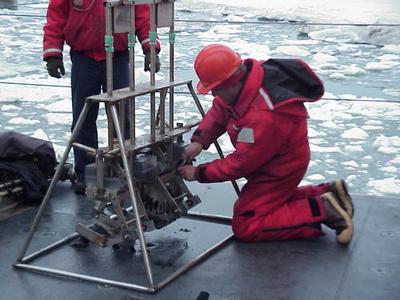
|
|
22 July, 2002
The around the clock nature of science at sea
continues to amaze me. There is someone in one of the
labs, at their computer, or on deck sampling at any
hour of the day or night. Many of the samples that are
taken must be processed immediately. Others will be
preserved for transportation to a lab where the work
will be done once the cruise is ended. The actual
analysis will take several months in most cases and
could easily take much longer.
Do you remember the picture of the hard hat from
yesterday? It was the one named Bering Gifts. I
thought you might be interested to know how Bering
Strait got its name. In 1648 Semyon Dezhnez became
the first person to sail around the northeast corner
of Asia from the Pacific into the Arctic Ocean. The
credit for discovery however, went to a Danish officer
in the Russian navy. Vitus Bering “rediscovered” the
strait in 1728. Bering was later sent on a scientific
survey of the area and he succeeded in discovering
Alaska in 1741 only to die in a ship wreck during his
return voyage. Although someone else had actually
been there first, Vitus Bering was given credit for
the discovery, and Bering Strait was named for him.
Today has been foggy and cold. The beautiful sun you
saw in the pictures from the first two days is gone
and it’s much tougher to stay warm during outdoor
stations. Most people have changed to mustang suits
(a full-body, bright orange, immersion survival suit)
for warmth and protection. Check it out below;
personally I think it’s a real fashion statement!
Today’s station began even as we were processing our
mud from the last station. After dinner we went out
to take our grab samples and do the multi-Haps core.
As you can imagine, any kind of coring device goes to
the bottom to take a core out of the sediments.
(Think of coring an apple.) The haps core was
invented by a Danish scientist, and it typically takes
one sample at a time. Jackie Grebmeier actually
designed the one you see in the picture. I think you
can tell that it is far more efficient; it takes four
core samples each time it is sent down. Once the
samples are brought to the surface, Jackie takes two
for her work with respiration (I’ll explain that more
later on). She then checks the others to see which
will be best to section (take certain size slices) to
preserve the mud. The sections are placed into cans,
labeled and sealed. Later they will be analyzed for
various “tracers” which will track organic carbon.
She will analyze cesium, thorium-234, lead-210,
beryllium-7 and other tracers in order to figure out
where the carbon came from and how long it has been in
the sediments.
Once again, the station lasted much longer than
originally planned. I’m starting to realize that this
not at all uncommon. Last night it was the up and
down of the helicopters that stopped us once again.
After the helicopters were finally back in their
hanger for the night, we took a bottom grab and
realized we had drifted substantially off station. We
packed up once again and headed back to the correct
position. Each time we came in off deck, we had to
remove our mustang suits, gloves, hats, and steel-toed
boots. A half hour later we would put it all back on
and go out again. At that time of the night/morning
there is not much to do during “breaks” so people head
to the mess for coffee and snacks. The cooks even
provide mid-rats (midnight rations), served from 11 –
midnight, for those who miss dinner because they
cannot interrupt their work. The food is great, but
it seems to be the coffee that keeps people going.
During most times of the day, people with coffee mugs
in their hands are a common sight.

Lee Cooper is removing one of the cores from the multi Haps core sampler. He's wearing a mustang suit for protection from the cold and just in case he goes overboard! The mustang suit (or life vest) and hard hat are mandatory on deck when equipment is in use.

Once we remove the cores Jackie Grebmeier picks two for her respiration experiments. She will add sea water to each one and allow the organisms to respire (breath) normally for a period of time before she analyzes the results.
Contact the TEA in the field at
.
If you cannot connect through your browser, copy the
TEA's e-mail address in the "To:" line of
your favorite e-mail package.
|
